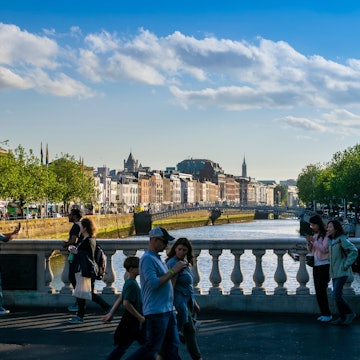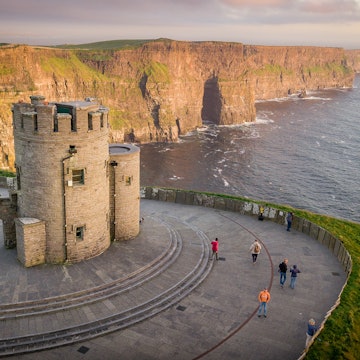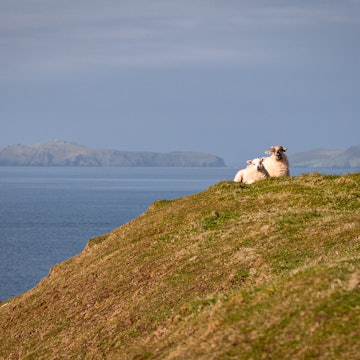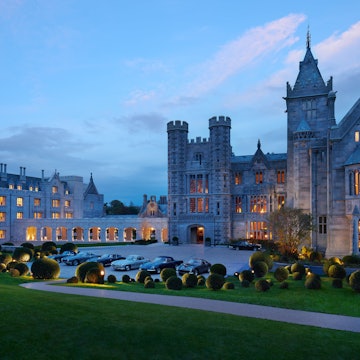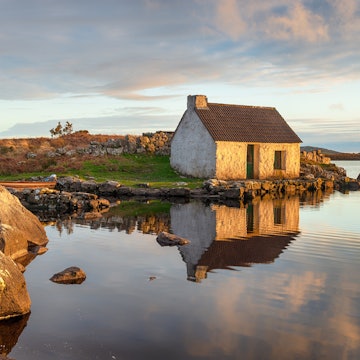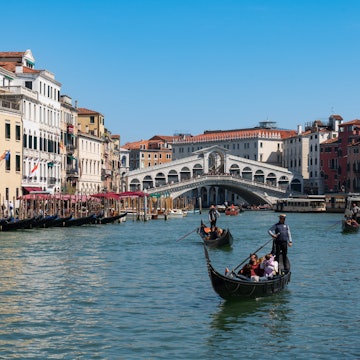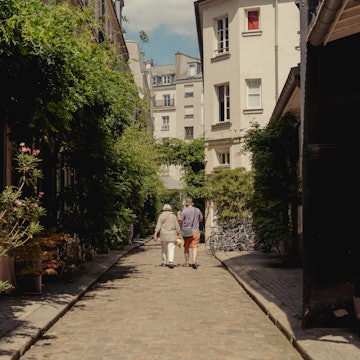

Graiguenamanagh, Kilkenny. Dylan Vaughan/Fáilte Ireland
If you’ve ever stumbled over an Irish friend’s name, you may find the same challenge with the pronunciation of many small towns and villages in Ireland. Over the years, their spellings were often twisted by Anglicization. Yet even in their altered forms, the names reflect the beauty of their surroundings, from a monastery burrowed into green hills to the stony grandeur of a limestone backdrop or a village clinging to a windswept cliff. Some names also offer a glimpse of a colorful past in a way only the Irish language can.
You don’t need to be a Gaeilgeoir (Irish speaker) to sense how these villages got their names. You can see it in the ruined tower houses, ocean bluffs, and ancient forts that still hold the essence of Irish life from another time. You can hear it too in the call of a church bell, the hum of tractors, and the chatter from a painted pub where the name above the door has belonged to the same family for generations.
There are many beautiful small towns and villages in Ireland, places that have held onto their character and glorious settings over the centuries. Here's our pick of the best.
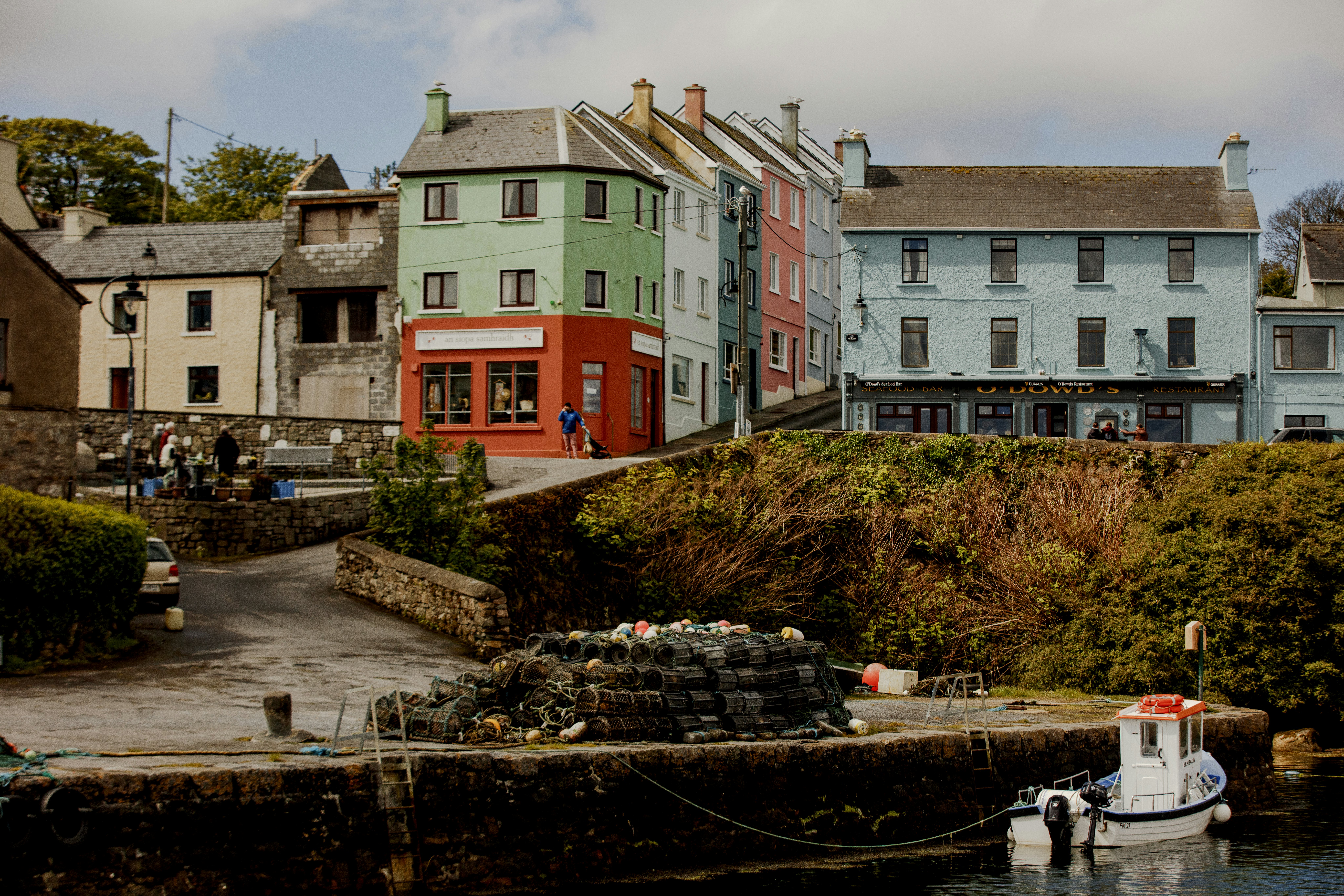
1. Roundstone, County Galway
Best for harbor life, music and local crafts
Roundstone rises, colorful and curved, above Bertraghboy Bay, its main street climbing gently up Errisbeg Hill. Fishing boats and artists share the harbor, looking across the water to the Twelve Bens mountains. Cafes punctuate the higgledy-piggledy streetscape beside shops selling hand-knitted Aran sweaters and woolens.
O’Dowd’s Seafood Bar & Restaurant overlooks the ocean, its window tables framing the view. Timber paneling, a wrought-iron fireplace, and maritime decor stave off the chill, while fresh seafood dominates the menu, from creamy chowder to pan-seared fish.
Musicians and artists have long found inspiration here, from Sting writing much of Zenyatta Mondatta in a house near the bay to the melodies that spill out from the doors of Roundstone’s pubs.
Planning tip: Venture beyond the village to Dog’s Bay and neighboring Gurteen Bay, which form twin white crescents of sand, separated by a rare tombolo and backed by dunes that glow copper in the evening light.

2. Ramelton, County Donegal
Best for Georgian architecture and riverside reflections
At the point where the River Lennon meets Lough Swilly, Ramelton still keeps its 18th-century grace. Georgian terraces and quayside warehouses stand intact, their proportions symmetrical and exact. Conway’s Bar, a thatched favorite on Castle St, is a fine example of early 19th-century vernacular architecture that lures guests with the glow from its windows and the sound of fiddle or bodhrán (a hand-held goatskin drum), while The Blue Goat, in a handsome warehouse on the quay, offers excellent local food.
Once a busy port sending beer, hides and salt fish to Glasgow and Liverpool, Ramelton never gained the railway or the deeper harbor that might have transformed it. That lack of progress became a kind of preservation, leaving a streetscape of stone warehouses, fanlighted doors and balanced facades reflected in the tidal water.
Detour: Follow the Inishowen Peninsula 160km drive north to Malin Head for sweeping Atlantic views, golden beaches, and Ireland’s northernmost point.

3. Schull, County Cork
Best for sailing, browsing and coastal energy
Schull curves around a deep bay beneath Mt Gabriel, its harbor dotted with schooners, yachts and fishing boats. Main St hums with cafes, galleries and Worm Books, a treasure trove of Irish literature, maps and local stories. Overlooking the harbor, the ivy-clad St Mary’s Church holds the grave of Rev Robert Traill, famine-era rector and grandfather of playwright JM Synge, remembered for his courage and care.
From here, head north along the Butter Road Walk toward Ballydehob, passing fields and stone walls before ending at Levis’ Corner House, known for its intimate music sessions. Schull is also the gateway to the Mizen Head peninsula, with its copper mines, white sands of Barleycove, and a cliff-edge footbridge that crosses over the Atlantic to a signal station. Back in town, behind the wine-colored facade of Hackett’s Pub, evenings remain lively with traditional music and local brews.
Planning tip: Visit during the Fastnet Film Festival (May), when pubs and bookshops host screenings and the village hums with creative energy.

4. Terryglass, County Tipperary
Best for lakeside evenings and hidden wells
At the quiet northeastern edge of Lough Derg, where the Shannon slips into County Tipperary, Terryglass is one of those places you find by accident, unless, of course, recommended by a trusted guide. A narrow lane bends around a small sandstone bridge where 200-year-old Paddy’s Bar and The Derg Inn sit almost on the roadside, their windows glowing on a cool evening. Behind them, the mossy walls of an old monastery and cemetery, an ivy-clad church, and a vernacular community hall form the village center.
Up the hill stands a limestone church and graveyard, overlooked by a statue of Christ. Down a winding road, the village opens onto its pier, where boats of every kind rest in still water or even submerged below the surface. Just beyond another small bridge, St Augh’s Well, known as the Eye Well, sits hidden in a thicket, once visited for its healing spring.
Planning tip: Hire a boat to explore Lough Derg’s other achingly beautiful villages, including Killaloe, Mountshannon, Dromineer and Garrykennedy.
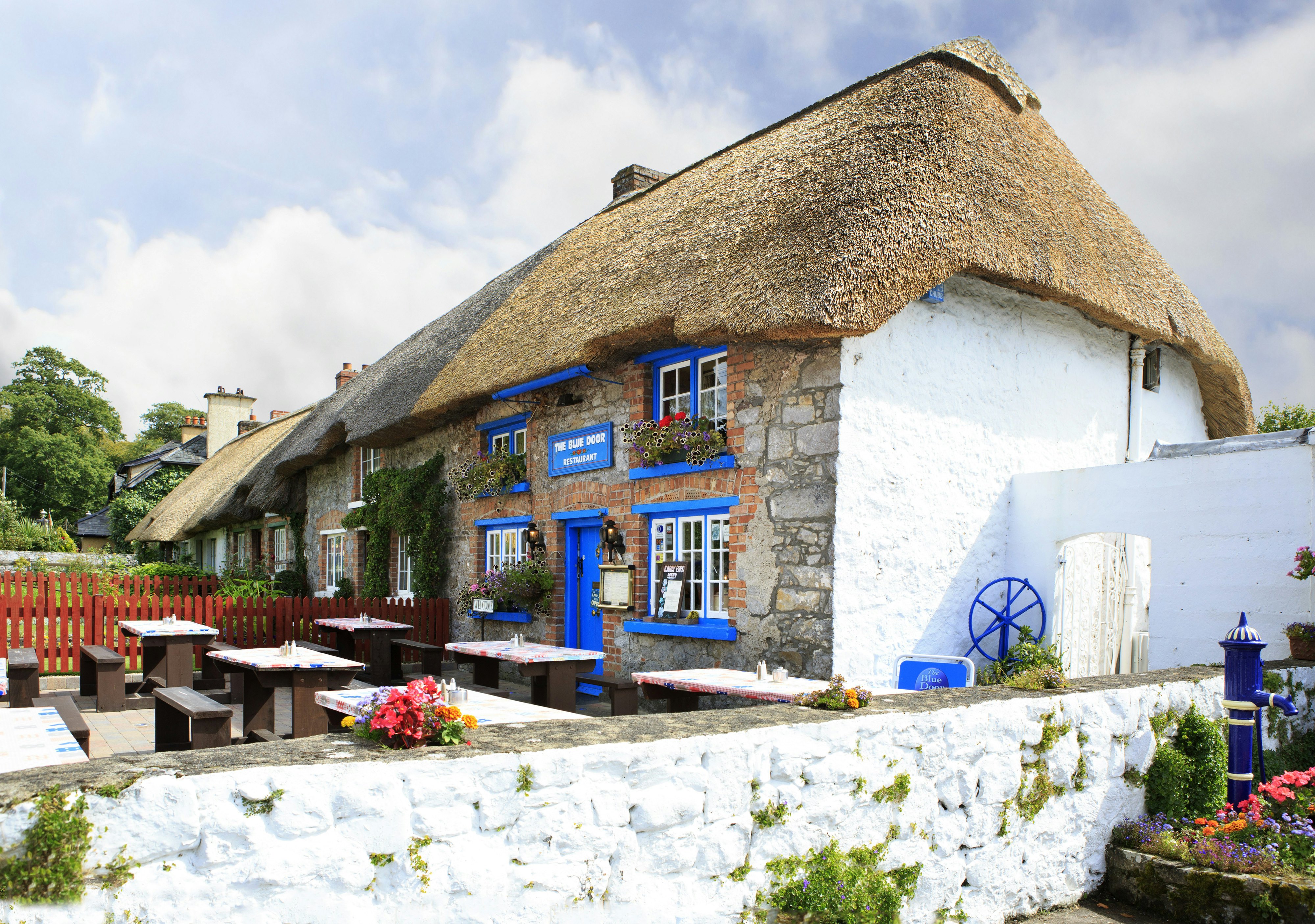
5. Adare, County Limerick
Best for Gothic grandeur and thatched cottages
Adare’s thatched cottages line the approach to its main street like a Paul Henry painting brought to life. The ruin of Desmond Castle broods by a riverbank at the town’s entrance, as though disapproving of the lavish developments that have taken place beyond. The manicured grounds of Adare Manor, a Gothic masterpiece, take center stage as the estate prepares to host the 2027 Ryder Cup. Stone bridges span the gentle River Maigue, and the village manages to blend its extravagant architecture with an elegant Irish streetscape: have lunch or afternoon tea at 1826, browse through the farmers market and heritage center, or take a quiet walk along the riverbank.
Planning tip: Arrive early to explore before the day-trippers and tour buses arrive.

6. Lismore, County Waterford
Best for castle views and abandoned follies
Lismore Castle rises above the River Blackwater, its battlemented towers and turrets defining the skyline. Built around a central courtyard from medieval, 17th- and 19th-century stonework, it commands the town and river, set among terraced gardens and wooded grounds.
Lismore’s lime tree-lined streets mix arts and crafts charm with Georgian order. The Heritage Centre tells of monks, dukes and writers, Foley’s on the Mall serves local produce, and the Red House Inn tosses a curve ball at the more subdued architecture on the street, with its striking brickwork and high pitches; it’s also good for a pint and tune. At the northern approach, the 1872 Gothic Revival fountain carved in limestone remains one of the town’s most elegant landmarks.
Planning tip: Walk over to Ballysaggartmore Towers, a romantic folly of soaring ambition and faded fortune.

7. Ballyvaughan, County Clare
Best for whiskey, and hikes on the surrounding limestone hills
On the edge of Galway Bay on the northern ridge of the Burren, Ballyvaughan sits between smooth limestone hills and the ocean. Down by the pier, where ferry boats from nearby Doolin often take shelter from rough winter seas, you’ll find Monk’s Pub. Its black fireplace against a whitewashed wall still radiates warmth, and the seafood chowder is just as comforting.
It’s a small village, more a wiggly fork in the road than a main street, with thatched cottages at one end and two-story vernacular buildings at the other. Just out of view of the ocean is O’Loclainn’s, Ireland’s most famous whiskey bar, with its crammed shelves behind the counter. It tends to open when it feels like it, so don’t plan your day too tightly.
Planning tip: Visit in May when the Burren is in full bloom and before the summer crowds arrive.

8. Inis Oírr, Aran Islands, County Galway
Best for stone walls and ocean air
Baile an Lurgáin on Inis Oirr, the smallest of the Aran Islands, is a compact world of low drystone walls and occasional green fields where donkeys peer idly over gates. The village settles into a peaceful rhythm once the day-trippers sail back to the mainland. It’s a tangle of narrow lanes winding around white cottages, all converging at a small hub with the local hotel and Tigh Ruairí’s Pub offering warm island hospitality. Climb higher for organic fare in the tightly packed quarters of Teach an Tae.
To the west, O’Brien’s Castle, the ruined stronghold of a chieftain, stands beside a Napoleonic tower, almost casting a shadow, while to the south, the village tapers into a bone-white beach. It’s a largely car-free island, so hire a bike to navigate the lanes and then wander to Tigh Ned’s for a pint as the sun drops low and ocean waves lap against the shore.
Planning tip: Ferries run from Doolin from March to November with optional tours under the Cliffs of Moher. Ros a’ Mhíl has a ferry service all year.

9. Graiguenamanagh, County Kilkenny
Best for monks and real pub life
Graiguenamanagh (village of the monks), sits beside the River Barrow, framed by the Blackstairs Mountains, its calm waters reflecting stone bridges and moored canal boats. At its heart stands Duiske Abbey, an early 13th-century Cistercian monastery whose weathered stone echoes with tales passed down through generations. Around it, streets curve with quiet grace, watched over by granite statues of monks marking the comings and goings and daily rhythms.
A seven-arched bridge spans the Barrow, linking Kilkenny to Carlow. Not far from it, Mick Doyle’s Pub has kept the local spirit alive for over half a century, with timber fixtures, unhurried pints and easy conversation.
Planning tip: Follow the towpath south toward St Mullins for a peaceful riverside walk through beech woods and gentle hills.

10. Kinsale, County Cork
Best for food, color and salty sea breezes
Though slightly larger than most on this list, no gathering of Ireland’s most beautiful small towns would be complete without Kinsale. Cobbled lanes cascade down its hillside setting to the harbor, carrying a trace of the town’s pirate past on the salty sea air.
Kinsale first defined, and continues to perfect, Ireland’s role as a center for artisanal food. Some of the country’s best dining spills from small coral, saffron and blue-painted buildings that zigzag in line with the haphazard streetscape. Restaurants such as Fishy Fishy and The Black Pig showcase the freshest fare, often moving straight from farm or trawler to plate. Its heart lies in its maritime past: Charles Fort crouches at the edge of the sea, while fishers' stories still drift through its pubs. Take the Scilly Walk to the Bulman Bar and end with the harbor unfolding wide before you.
Planning tip: Visit in spring or fall when the weather is mild and the town is lively but not crowded.

11. Carlingford, County Louth
Best for medieval lanes and sea views
Between the Cooley Mountains and the Irish Sea, Carlingford has kept its medieval bones through a twist of fortune. A decline in fishing, rather than any grand plan, preserved its narrow lanes, ancient walls and limestone buildings. Tower houses, an old mint and cobbled streets mix with bars and cafes where the past feels stitched into the present.
For nearly a millennium, Carlingford Castle has stood on the shore like a steadfast general facing the glittering lough. When the wind sweeps in, take shelter by the open fire in PJ O’Hare’s with a pint of stout and a plate of oysters.
Planning tip: Take a different view of Carlingford from the Lough aboard a ferry with sweeping views of the Mourne Mountains and Cooley Peninsula (seasonal sailings).

12. Cahir, County Tipperary
Best for castles, cafes and riverside walks
The River Suir cuts through Cahir, where one of Ireland's largest castles seems to rise from the water on an island in the heart of town. Its pewter-hued stone towers are mirrored in the river, making the castle feel even more imposing on a clear day. Yet despite the grandeur of its noble heritage, Cahir remains a market town at heart, centered on a quiet square.
Life is lived along narrow streets lined with family-run cafes and bakeries, where the smell of fresh bread drifts out to meet the hum of conversation. Sidestep into Cahir House, an elegant 18th-century townhouse with limestone dressings and Venetian windows, for a pint by the fire and a taste of old Cahir.
Planning tip: Follow the riverside path from the castle to the Swiss Cottage for a tranquil woodland walk beside the Suir.








